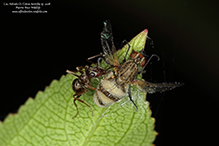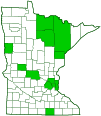Fly death fungus
(Entomophthora muscae)
Conservation • Description • Habitat • Ecology • Distribution • Taxonomy
Conservation Status |
|||
| IUCN Red List | not listed |
||
| NatureServe | NNR - Unranked |
||
| Minnesota | not listed |
||
Description
Entomophthora muscae is a common zygote fungus that attacks and kills adult flies. It occurs worldwide in the Tropical and Temperate Zones. It occurs in the United States and southern Canada east of the Great Plains and on the West Coast, with few scattered records between.
Entomophthora muscae attacks flies in the families Muscidae, Calliphoridae, Sarcophagidae, Tachinidae, Drosophilidae, Scatophagidae, Culicidae and Syrphidae. Outbreaks typically occur in the spring and fall, when cooler temperatures and humid conditions are most suitable for spread of the fungal spores.
A fly is infected when a single airborne spore lands on it. When the spore germinates, the fungus penetrates the fly’s cuticle, and fungal threads (hyphae) spread throughout the body. As the fungus grows, the abdomen becomes distended, exposing the membranous portion on the abdomen and giving the fly a striped appearance. The fungus also attacks the fly’s brain and controls its behavior. It causes the fly to crawl to an elevated position, often to the tip of a stem, flower, or leaf, and attach itself with its tube-like mouthparts (proboscis). The hyphae secrete a glue-like substance that firmly holds the body in place.
The fly dies five to seven days after becoming infected. The dead fly has its wings spread outward, the legs stretched out, and the body angled away from the surface. This is an ideal position for the spores to be spread widely. About three hours after the fly’s death, the hyphae force cracks in the areas between the segments. It produces numerous, large, spore-bearing structures (conidiophores), each one with a single spore (conidium). This gives the abdomen a fluffy appearance.
A smaller, secondary conidiophore is often developed at the tip of a primary conidiophore. When it matures, within about three hours, it forcibly ejects conidia into the surrounding area, resulting in a “conidial shower.” When this happens on a window, the result is a large “halo” around the dead fly.
Male flies often try to mate with the corpse of a dead infected female, picking up spores in the process.
Similar Species
Entomophthora syrphi attacks only hover flies (family Syrphidae).
Habitat and Hosts
Flies in the families Muscidae, Calliphoridae, Sarcophagidae, Tachinidae, Drosophilidae, Scatophagidae, Culicidae and Syrphidae
Ecology
Season
Year round
Distribution |
||
|
Sources |
|
| 10/11/2025 | ||
Occurrence |
||
Common |
||
Taxonomy
Kingdom
Fungi (Fungi)
Subkingdom
Zoopagomyceta
Phylum
Zoopagomycota (Zygote Fungi)
Subphylum
Entomophthoromycotina
Class
Entomophthoromycetes
Order
Entomophthorales (insect destroyers)
Family
Entomophthoraceae
Genus
Entomophthora
Species Complex
Complex Entomophthora muscae
Subordinate Taxa
Synonyms
Empusa muscae
Sporendonema muscae
Common Names
This species has no common name. The common name of the Complex Entomophthora muscae is Fly Death Fungi, and it is used here for convenience.
Glossary
Conidium
An asexual spore produced by some fungi. Plural: conidia.
Hypha
A thread-like cell of a fungus that is the main mode of vegetative growth: the basic structural unit of a multicellular fungus. Plural: hyphae. Collectively, the hyphae of a fungus is the mycelium.
Proboscis
The tube-like protruding mouthpart(s) of a sucking insect.
Visitor Photos
Share your photo of this fungus.
This button not working for you?
Simply email us at info@MinnesotaSeasons.com.
Attach one or more photos and, if you like, a caption.
Alfredo Colon |
 |
MinnesotaSeasons.com Photos
|

Slideshows

Visitor Videos
Share your video of this fungus.
This button not working for you?
Simply email us at info@MinnesotaSeasons.com.
Attach a video, a YouTube link, or a cloud storage link.
Other Videos
This Killer Fungus Turns Flies into Zombies | Deep Look
Deep Look
True Facts: Fungi That Control The Insects They Eat
Ze Frank




